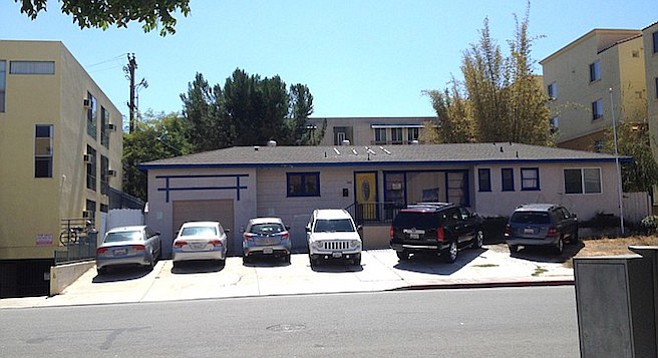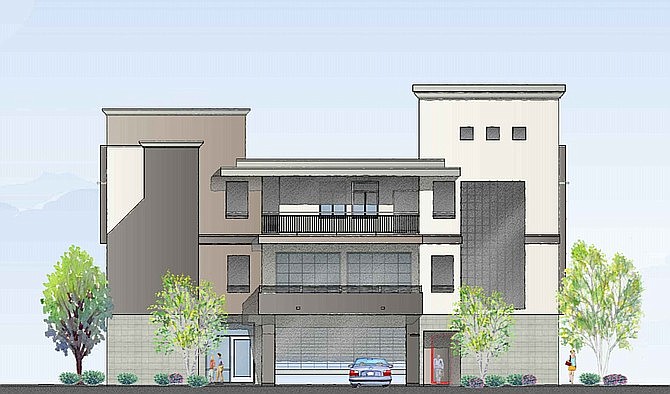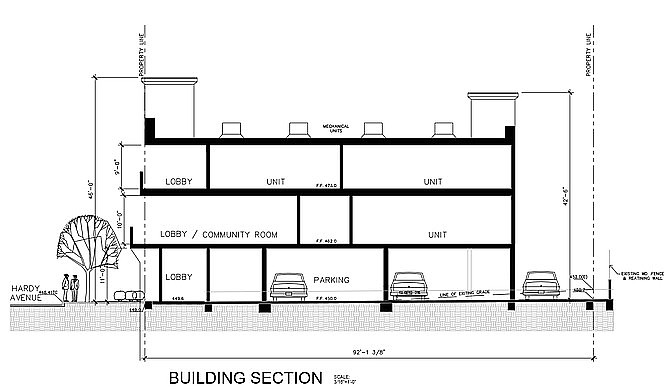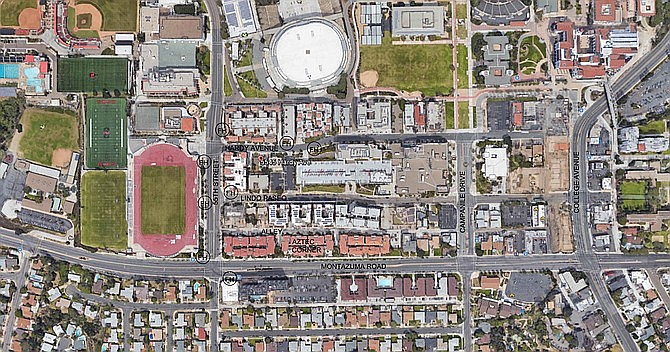 Facebook
Facebook
 X
X
 Instagram
Instagram
 TikTok
TikTok
 Youtube
Youtube

Originally built in 1951, the house on 5545 Hardy Avenue has been in the possession of the SDSU Delta Upsilon Fraternity since 1998. In May, the fraternity applied to demolish their one-story fraternity house and build a three-story apartment fraternity building with some deviations to lot coverage and parking regulations.
After reviewing the project for the second time, a letter went out to the applicant from the city on August 29. The letter pointed to 46 outstanding issues — including 24 that were new since the first go-round in June with 164 issues. The applicant has 90 days to address issues related to parking, the driveway, water, sewer, landscaping, stormwater run-off, an affordable housing exemption, and a live-in resident manager requirement.

José Reynoso, chair of the College Area Community Planning Board, said his group approved the project in July.
“Because this fraternity house is close to campus, there aren’t as many issues as with the mini-dorms wreaking havoc in surrounding neighborhoods. I do remember that the city was insisting on higher-density by adding another story to Hardy [from three to four]. The city was looking at the number of units and not the number of bedrooms. We felt there were enough living spaces to meet the requirements without increasing the structure. In addition, the building is for fraternity members and the proposed structure is planned to accommodate current and future members, not non-member residents. In addition, more units would increase the parking requirements which cannot be met with the space available.”

The frat house on Hardy sits on a block with other fraternities and mostly red and yellow curbs. The front yard has six parking spaces but sometimes one or two cars are parked on the front lawn.
“This is common," Reynoso said, "the mini-dorms in neighborhoods often pave over the backyard to create a parking lot. As far as parking for the house on Hardy, SDSU has a parking structure 200 feet away. From what I’ve heard they’re having trouble filling it. The city recommended some arrangement to have tenants park in the campus parking structures. I thought that was very creative. The campus gets more parking and the project can meet the city’s parking requirements, if necessary.”
Reynoso is on a mission to get more students closer to campus and out of the 800 mini-dorms in surrounding neighborhoods. He and other board and community members took the first step on September 14 at the local planning meeting by discussing what to do about the problem.

“Mini-dorms are destroying the fabric of neighborhoods,” said Reynoso. “Not only that, but it makes it harder for families to find housing when a landlord can rent a house to college students for $6000 versus the $2500 they can charge a family. What it does is take affordable housing off the market.
"Housing is expensive all over San Diego, but the College Area is not super expensive. It’s a move up from some communities, someone who lives in a condo or apartment and they want to move up, well they can move to the College Area and get something a little bit better for a reasonable price. If there were dormitories or student apartments closer to campus, in theory, 800 houses could be made available to families again. There are about 3500 single-family homes in the College Area; that means more than 20 percent are being used for dorms. That’s too many.”
Reynoso said an effort is underway to limit the number of bedrooms in mini-dorms. He thinks this could make the problem worse by creating the need for more mini-dorms and by consequence reducing the single-family housing stock even further.
“The real problem is the housing demand for students that isn’t being met near the campus. I’m proposing to push forward a request to the city to do a Specific Plan for the College Area. It will help speed up the permitting process for developers to three to six months, versus two to three years.”
Reynoso said the development would be focused immediately adjacent to the campus on Montezuma Road and College Avenue.
“Along Montezuma, 90 percent of the houses are already mini-dorms; if these properties are rezoned to higher density, it would benefit both the students and the property owners that can then rent to more students by redeveloping, and would slow the pace of conversions of single-family homes to student rentals....
“That is what we’re pushing for. It will have some character, with a commercial base focused on students but providing amenities that are also attractive to all residents, to create a true college town atmosphere with coffee houses, bookstores, bars, shops, and restaurants.”
Reynoso thinks if a comprehensive approach is pursued, only then will it make sense to have a mini-dorm ordinance in place.
Reynoso also pointed to problems that could arise if and when the current mini-dorms go back on the market for families to buy. He said restoring an eight-bedroom mini-dorm back to its original three-bedroom condition could be cost-prohibitive for some.
Reynoso plans to make a formal motion at the October planning meeting to ask the city to look into moving forward with his plan.


Originally built in 1951, the house on 5545 Hardy Avenue has been in the possession of the SDSU Delta Upsilon Fraternity since 1998. In May, the fraternity applied to demolish their one-story fraternity house and build a three-story apartment fraternity building with some deviations to lot coverage and parking regulations.
After reviewing the project for the second time, a letter went out to the applicant from the city on August 29. The letter pointed to 46 outstanding issues — including 24 that were new since the first go-round in June with 164 issues. The applicant has 90 days to address issues related to parking, the driveway, water, sewer, landscaping, stormwater run-off, an affordable housing exemption, and a live-in resident manager requirement.

José Reynoso, chair of the College Area Community Planning Board, said his group approved the project in July.
“Because this fraternity house is close to campus, there aren’t as many issues as with the mini-dorms wreaking havoc in surrounding neighborhoods. I do remember that the city was insisting on higher-density by adding another story to Hardy [from three to four]. The city was looking at the number of units and not the number of bedrooms. We felt there were enough living spaces to meet the requirements without increasing the structure. In addition, the building is for fraternity members and the proposed structure is planned to accommodate current and future members, not non-member residents. In addition, more units would increase the parking requirements which cannot be met with the space available.”

The frat house on Hardy sits on a block with other fraternities and mostly red and yellow curbs. The front yard has six parking spaces but sometimes one or two cars are parked on the front lawn.
“This is common," Reynoso said, "the mini-dorms in neighborhoods often pave over the backyard to create a parking lot. As far as parking for the house on Hardy, SDSU has a parking structure 200 feet away. From what I’ve heard they’re having trouble filling it. The city recommended some arrangement to have tenants park in the campus parking structures. I thought that was very creative. The campus gets more parking and the project can meet the city’s parking requirements, if necessary.”
Reynoso is on a mission to get more students closer to campus and out of the 800 mini-dorms in surrounding neighborhoods. He and other board and community members took the first step on September 14 at the local planning meeting by discussing what to do about the problem.

“Mini-dorms are destroying the fabric of neighborhoods,” said Reynoso. “Not only that, but it makes it harder for families to find housing when a landlord can rent a house to college students for $6000 versus the $2500 they can charge a family. What it does is take affordable housing off the market.
"Housing is expensive all over San Diego, but the College Area is not super expensive. It’s a move up from some communities, someone who lives in a condo or apartment and they want to move up, well they can move to the College Area and get something a little bit better for a reasonable price. If there were dormitories or student apartments closer to campus, in theory, 800 houses could be made available to families again. There are about 3500 single-family homes in the College Area; that means more than 20 percent are being used for dorms. That’s too many.”
Reynoso said an effort is underway to limit the number of bedrooms in mini-dorms. He thinks this could make the problem worse by creating the need for more mini-dorms and by consequence reducing the single-family housing stock even further.
“The real problem is the housing demand for students that isn’t being met near the campus. I’m proposing to push forward a request to the city to do a Specific Plan for the College Area. It will help speed up the permitting process for developers to three to six months, versus two to three years.”
Reynoso said the development would be focused immediately adjacent to the campus on Montezuma Road and College Avenue.
“Along Montezuma, 90 percent of the houses are already mini-dorms; if these properties are rezoned to higher density, it would benefit both the students and the property owners that can then rent to more students by redeveloping, and would slow the pace of conversions of single-family homes to student rentals....
“That is what we’re pushing for. It will have some character, with a commercial base focused on students but providing amenities that are also attractive to all residents, to create a true college town atmosphere with coffee houses, bookstores, bars, shops, and restaurants.”
Reynoso thinks if a comprehensive approach is pursued, only then will it make sense to have a mini-dorm ordinance in place.
Reynoso also pointed to problems that could arise if and when the current mini-dorms go back on the market for families to buy. He said restoring an eight-bedroom mini-dorm back to its original three-bedroom condition could be cost-prohibitive for some.
Reynoso plans to make a formal motion at the October planning meeting to ask the city to look into moving forward with his plan.
Comments